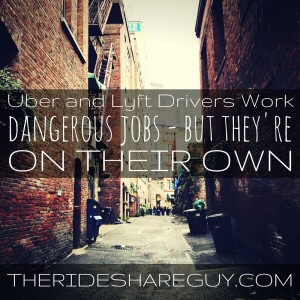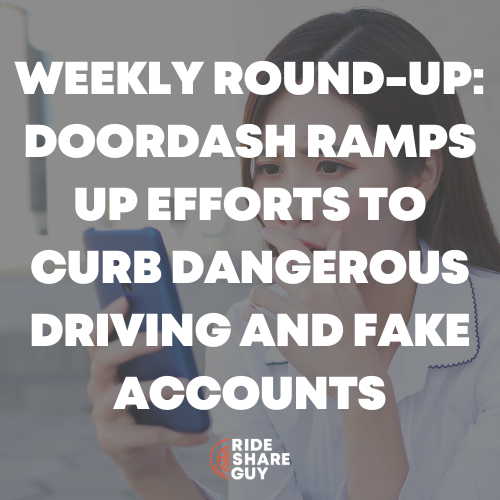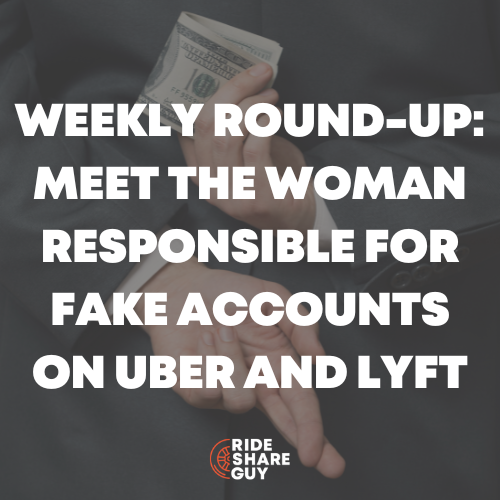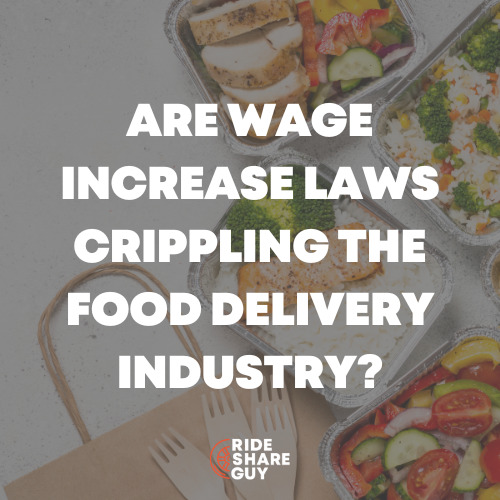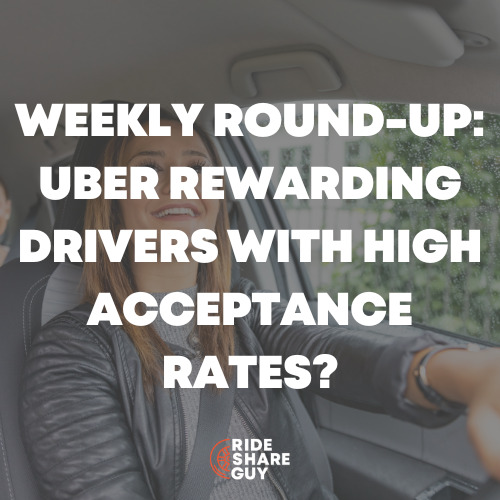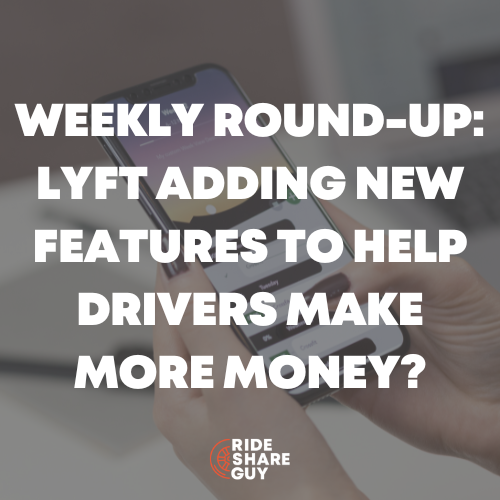Harry here. I’ll be heading to Hong Kong and Southeast Asia for a couple weeks with the wife today, but the blog will continue as normal. If you have an urgent e-mail, I’ll still try and respond, but otherwise, please don’t expect a response for a couple weeks.
Today, RSG contributor John Ince looks at a serious subject though: driver safety. We all joke about the crazy passenger stories we rack up, but there’s also no denying that there are legitimate safety concerns that drivers face on a daily basis. Some of them are beyond our control, but others most definitely aren’t.
Uber and Lyft Drivers Work Dangerous Jobs—But They’re on Their Own
Sum and Substance: Harry Campbell was driving a man home one night when, upon stopping at a light, the passenger stripped off all of his clothes, ran naked around the car, and then got back in as if nothing at all had happened.
Odd, yes, but just another night as an Uber driver. Even now, Campbell is nonplussed. “I think it was a dare,” he says. “Every driver has a story like that.” Or worse. Uber horror stories are nothing new. But most of them are stories about passengers victimized by drivers.
Such headlines are hardly exclusive to Uber; plenty of sharing economy ventures bring their share of cautionary tales. “When you get into a taxi, there’s a reason there’s plexiglass between you and the driver.”
What gets far less attention is the abuse, verbal and physical, that drivers endure. In November, a shocking video of a drunken Taco Bell executive beating an Uber driver went viral. More recently, a witness filmed a Miami doctor trying to kick a driver before trashing his car. And these are just a few incidents that made headlines.
No matter what you call it, providing rides to strangers carries the risk of harassment and violence—it’s why your parents told you never to pick up hitchhikers. But while the risk to passengers of using ridesharing services has been widely debated, the risk to drivers has been largely ignored. Just how great a risk drivers face is difficult to quantify. Because the ridesharing industry is so new, and laws regulating it so patchwork, official figures are tough to come by, and the big companies don’t share specifics about incidents their drivers report. Still, online forums for drivers brim with descriptions of attacks on drivers by passengers, both verbal and physical, such as a driver posted a video of being spit on and punched.
My Take: This is the best article I’ve read on a greatly overlooked issue – driver safety. The author has obviously done her homework – including an interview with our own Harry Campbell. The key issue here is the fact that Uber and Lyft are hamstrung – they can’t offer driver’s safety training without jeopardizing their business model, because training programs are considered a key component of an employee relationship – and by now every driver knows that they are independent contractors. So we’re basically left to fend for ourselves.
There are many nuances to the safety issue though. We’re told to kick out unruly passengers, but the very process of kicking them out often triggers a confrontation. We’re told we’re under no obligation to pick up a drunk passenger, but frequently the drunk is in the car before you know how drunk they are – and then it’s too late. We’re told we don’t have to accept rides from areas where there might be a safety issue, but how do you know before you get there and what about those time outs that Uber now imposes for drivers who cancel too often?
What do you think? Is this an issue that deserves closer scrutiny? What can be done – besides dash cams – to make it safer?
California drivers: Don’t have time to sit forever in the doctor’s waiting room? Skip the line to get advice and prescriptions from a doctor on Remedy’s app. Message a personal doctor without leaving your home or car and get treatment for most common conditions. Prescriptions sent to your nearest pharmacy. For more information, visit Remedy here.
Uber driver killed in Detroit – Police find Modou Diagne shot twice, dead on city’s west side
Sum and Substance: Modou Diagne came from his native Senegal to Detroit in search of a better life. He had been driving for Uber for the past three years to support his wife and children. “He was working all the time, no days off. Sometimes 19 hours a day,” said niece Fatima Diop.
So it was no surprise Diagne was driving Saturday night into Sunday morning. His car crashed at the intersection of Livernois and Joy on the city’s west side. At first, people thought it was a case of drunk driving, until police got to the scene and realized he’d been shot twice and was dead.
Uber drivers carry no cash, but whoever did this to him stole his phone. Police paid a visit to the family’s west side home to give them the news. His wife, Batal, is pregnant, and she already has three children under the age of 6. Her English is limited, but she told Local 4 News through a family member she has nowhere to go and doesn’t feel safe.
My Take: This is just a horrible tragedy, and it underlines all that was said in the article above with a huge exclamation point. Here a guy is working so hard just to make ends meet and then meets this end. I’m pretty much at a loss for words to describe how bad this makes me feel. Does it hit you as hard as it hits me?
UBER DRIVER FATALLY SHOT IN INGLEWOOD
Sum and Substance: An investigation is underway after an Uber driver was fatally shot in Inglewood early Sunday morning, police said. Authorities responded to the 3700 block of W. 109th Street around 4 a.m. following several reports of shots fired. Upon their arrival, they found a man who had been struck by gunfire. His vehicle, a black Nissan with dealer plates, was riddled with bullet holes.
The victim, identified as Andre Jamal Bayyan, was pronounced dead at the scene. Bayyan’s age was not released but officials said he was from Los Angeles. An Uber spokesperson confirmed Bayyan was on a trip at the time of his murder, but did not clarify if he was en route to pick a passenger up or if he was dropping someone off when he was fatally shot.
My Take: Yet another Uber driver killed. This one on right on the heels of the Detroit shooting. Make no mistake about it, being a driver is a dangerous occupation.
The Uber Model, It Turns Out, Doesn’t Translate
Sum and Substance: Investors saw Uber’s success as a template for Ubers for everything. “The industry went through a period where we said, let’s look at any big service industry, stick ‘on-demand’ on it, and we’ve got an Uber,” said Hunter Walk, a venture capitalist at the firm Homebrew, which has invested in at least one on-demand company, the shipping service Shyp.
But Uber’s success was in many ways unique. For one thing, it was attacking a vulnerable market. In many cities, the taxi business was a customer-unfriendly protectionist racket that artificially inflated prices and cared little about customer service. The opportunity for Uber to become a regular part of people’s lives was huge. Many people take cars every day, so hook them once and you have repeat customers.
Finally, cars are the second-most-expensive things people buy, and the most frequent thing we do with them is park. That monumental inefficiency left Uber ample room to extract a profit even after undercutting what we now pay for cars.
But how many other markets are there like that? Not many. Some services were used frequently by consumers, but weren’t that valuable — things related to food, for instance, offered low margins. Other businesses funded in low-frequency and low-value areas “were a trap,” Mr. Walk said. Another problem was that funding distorted on-demand businesses. So many start-ups raised so much cash in 2014 and 2015 that they were freed from the pressure of having to make money on each of their orders. Now that investor appetite for on-demand companies has cooled, companies have been forced to return sanity to their business, sometimes by raising prices.
My Take: This is a thoughtful article that explores the “Uber for Everything” phenomenon that seems to have infected tech culture. Building on Uber’s success, a parade of entrepreneurs sought to wring inefficiencies out of all kinds of common tasks, some raising huge sums of capital from investors who were blinded by Uber’s incredible valuations.
Now reality has set in and people are discovering that there were unique circumstances that led to Uber’s ability to scale so quickly. My only beef with this article is the assumption that Uber is a unique success story. In my view, Uber has yet to demonstrate that they have a viable business model. Yes, they’ve demonstrated that they can scale quickly, but at what cost? Remember Uber lost $1.7 billion during the first three quarters of 2015 – more than even Amazon lost during their worst quarter ever.
Exclusive: Lyft drivers, if employees, owed millions more – court documents
Sum and Substance: Drivers who worked for ride-hailing service Lyft in California during the past four years would have been entitled to an estimated $126 million in expense reimbursements had they been employees rather than contractors, court documents show.
Lyft and larger rival Uber Technologies Inc face legal actions from drivers who contend they should be classified as employees and therefore entitled to reimbursement for expenses, including gas and vehicle maintenance. Drivers currently pay those costs themselves.
The new figures, requested by a judge and calculated by attorneys for the drivers based on data supplied by Lyft, provide a rare glimpse into how much ride-hailing services may save by classifying drivers as independent contractors rather than employees. Lyft agreed to settle the class-action lawsuit in January.
Under the proposed deal, Lyft would pay $12.25 million, with drivers receiving an average of $56 each after attorneys’ fees and other expenses, documents show. During settlement negotiations, attorneys for the plaintiffs said in filings that they believed drivers were entitled to expense reimbursements totaling $64 million, far less than the $126 million they had calculated after being provided with updated Lyft records.
The latest figures were submitted in response to questions about the proposed settlement from U.S. District Judge Vince Chhabria in San Francisco, who is expected to consider whether to preliminarily approve the deal at a hearing this week.
The Teamsters also filed a complaint against Lyft with the National Labor Relations Board, the federal agency charged with investigating and ruling on unfair labor practices.
My Take: What’s interesting here is that both Lyft and the drivers’ lawyers agreed to a much lesser settlement months ago, but the judge expressed concern. It’s basically the judge saying, “not so fast, maybe the drivers deserve more here.” The $126 million figure may not seen like that much in the context of the billions that Uber and Lyft have raised, but consider the fact that Lyft’s total loss last year was $127 million, increasing the settlement amount here would essentially double the size of the hole that Lyft is digging itself into.
This article also gives a fascinating peek into the actual data on drivers and how much they actually drove. For example, over half (83,000) of the companies’ 150,000 drivers in California drove less than 30 hours total over the four year period covered by the lawsuit.Think about that. For all the incentives and bonuses that Lyft offers trying to get drivers out on the road, most won’t bite. That tells you something about the experience. Most drivers for one reason or another just don’t find this worth their time.
On the other hand, a very small percentage of drivers, 1500, or roughly 10% of the 150,000 total, drove 1000 hours or more. The judge will make a preliminary ruling this week whether or not to approve the initial, $12 million settlement. My guess is that he’s going to reject that settlement and ask the parties to hash out another agreement.
In any event, if you’re one of the 1500 drivers who did yeoman’s work during this period, you could be in for a windfall. The average payment to drivers using the $126 million figure would be $835, but for the top 10% of drivers, the individual payout would be much larger. And remember this is all just a warmup to the much bigger trial in June over the same issues versus Uber. Note: The judge held hearings this week. Here’s an update from Bloomberg Business Week. Stay tuned folks.
Drivers, what do you think about the week’s top stories?
-John @ RSG
